Menu

By 2012, biotech crops had taken over in the United States. They made up 88 percent of corn, 94 percent of cotton, and 93 percent of soybeans. This data comes from the USDA’s National Agricultural Statistics Service (NASS). These numbers show the quick spread and full embrace of agricultural biotechnology. It employs new techniques to change plants, making agriculture more innovative.
New methods in agriculture build on old breeding practices. Today, experts use genetic editing to make crops better. This includes making them tougher against diseases and pests. It also boosts the amount they grow and improves the soil. These changes are key for keeping farming sustainable. The new plants, which are the result of gene editing, prove that we’re making food production safer and more efficient.
Genetic engineering in agriculture changes how we farm. It alters organisms’ genes to make better products. Farmers can grow crops that resist pests and tolerate herbicides. This helps farming be more sustainable and productive.
It’s not just about crops. Genetic engineering also includes using plants to clean up pollution. This is called phytoremediation. So, it’s not just about growing food but also helping the environment.
At its core, genetic engineering tweaks an organism’s DNA to get desired traits. It’s very precise, giving us plants that produce more, are of better quality, and tough out environmental stresses. Making these changes at the genetic level is a big step for agriculture.
Genetically modified (GM) crops have been a game-changer in farming, just like the green revolution. They have upped the amount of food we can plant. Key crops such as cotton, corn, soybeans, and canola are now made to fight off bugs and withstand weed killers. This lessens the need for chemical sprays and simplifies farming.
In the US, GM crops are widely used. In 2012, 88% of corn, 94% of cotton, and 93% of soybeans were GM. These crops don’t just produce more food. They also help farming be kinder to the planet by using less harmful sprays and reducing soil disturbance.
Genetic engineering also aids phytoremediation. By using modified plants, we can clean up polluted land. This is good for the environment. Plus, we can grow foods with more nutrients or medicines directly from plants. This shows the wide application of genetic engineering in farming.
| Crop | Percentage of GM Planted (US, 2012) | Benefits |
|---|---|---|
| Corn | 88% | Increased yield, pest resistance |
| Cotton | 94% | Pest resistance, reduced pesticide use |
| Soybeans | 93% | Herbicide tolerance, simplified farm work |
Genetic engineering in farming is always progressing. It aims to make farming friendlier to the earth while boosting production.
The story of changing crops is rich in our farming past, going back thousands of years. Early on, people used methods like choosing the best plants to sow the seeds of what we do now with genes directly. This laid the first stones for our modern abilities to change crop genes, which help us grow more food and protect the Earth better.
The first signs of picking the best plants to grow more started around 7800 BCE. Then, in 1922, we had our first taste of this with hybrid corn. It showed how we could make plants yield more or grow better by carefully picking which ones get to reproduce.
By the 1900s, farming was already seeing the benefits of these early tricks. Then in 1980, a big US court ruling said we could even patent bugs that were genetically changed. This opened doors to more research and legally protect new discoveries. Only two years later in 1982, we had our first major GMO product, human insulin. This marked a big step, showing how genetics could help in farming and medicine.
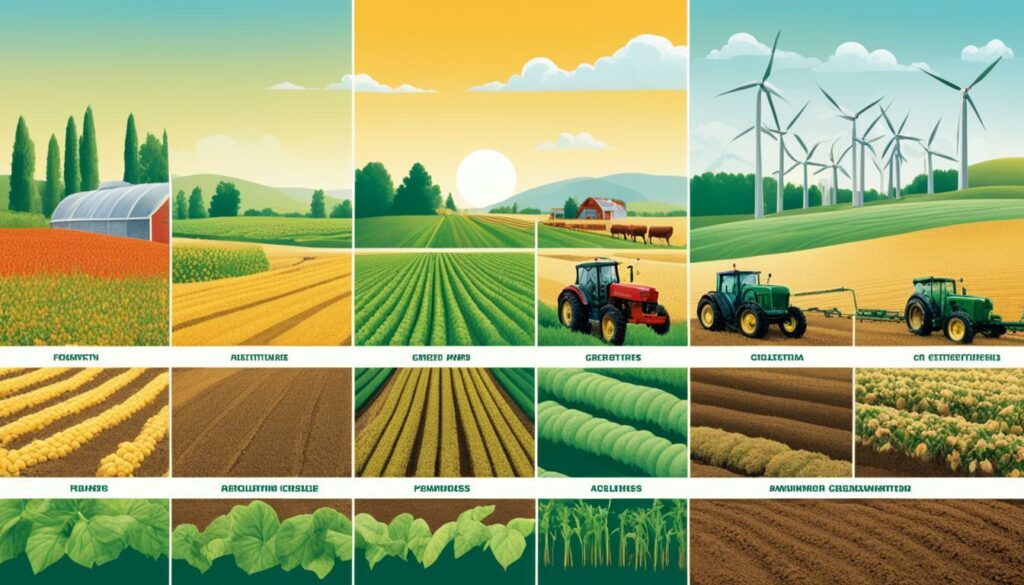
Discovering in the 20th century that we can move a plant’s DNA to another species was huge. It allowed us to improve plants in very specific ways. With this, in 1987, we started growing plants whose genes we changed, in fields. Eventually, we got the first GMO tomato, Flavr Savr, in our shops by 1994.
Regulating these new GMO plants began in 1986 to make sure they were safe and worked as planned. The rules for GMO foods became as strict as the ones for plants that hadn’t been genetically changed by 1992. These steps made room for many achievements, like growing GMO crops that can survive weed killers. Here are some highlights:
From Golden Rice in 2000, aimed at fighting vitamin A shortages, to the recent 2020 approval of pink pineapple, these success stories show the continuous march of genetic alteration. Today, people are more curious about GMOs than they have been in years, showing a growing trend.
GMO crops are changing farming by using genetic engineering. They’ve shown impressive results, like boosting rice’s beta-carotene by 30%. Also, genetically engineered salmon grew four times faster. This helps farmers and people who eat the crops.
GMO crops are better at fighting off pests and diseases. This means less need for harmful pesticides. For example, Bt corn has cut the loss of monarch larvae by 40% from its pollen. This drop in pesticide use cuts costs and is good for the planet.
Genetically modified crops are also boosting our economies. The genetic engineering field is growing by 6% every year. Even in Europe, they’re worth around $5 billion. Farmers get more product with fewer costs, making agriculture better and more profitable.
But, GMO crops face worries and risks, too. Their impact on the environment is a big concern. The introduction of some GMOs caused a 50% drop in monarch butterfly numbers, affecting biodiversity.
The safety of GMOs and the risk of food allergies are ongoing debates. Many are concerned, with 75% wanting stricter rules on GMO foods. To overcome these worries, thorough tests and clear communication are crucial to show GMOs are safe to eat.
It’s important to balance the advantages of GMO crops with potential environmental harm. This way, we can practice sustainable farming without endangering nature.
We must also watch the environmental concerns of genetic modification. The environment changing can affect genetic crop improvements by up to 70%. It shows we have to be careful with new farming methods not to upset the natural balance.
Biotechnology has led to the creation of many genetically modified crops. These crops are designed to solve specific farming challenges. For example, there are crops that resist insects and those that can withstand drought. They help farmers produce food more sustainably and effectively.
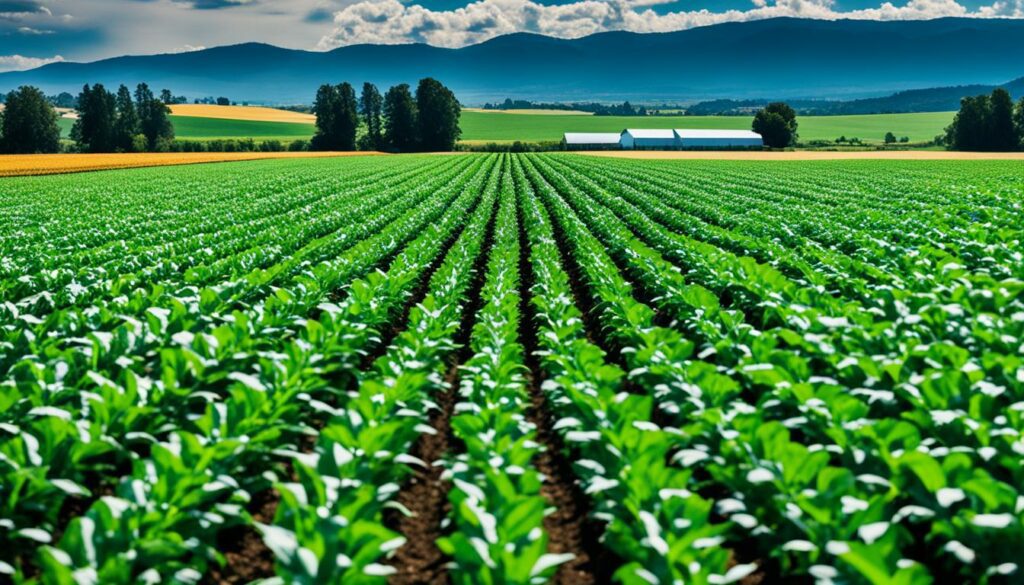
Plants like Bt corn and cotton have changed how we deal with pests. They have a gene from a bacteria that makes them naturally resistant to insects. This means farmers use fewer chemicals, which is better for the environment and their wallets. In the U.S., most cotton planted in 2020 was genetically modified. This shows how important these crops have become.
Climate change and water scarcity are big concerns. Drought-tolerant crops are a breakthrough in biotechnology. They can still produce well in areas with little water. For example, drought-tolerant corn uses water more efficiently. This makes it an important crop for places prone to drought. In 2020, most corn in the United States was genetically modified for drought tolerance.
| Crop Type | Percentage of GMO Planted (2020) |
|---|---|
| Soybeans | 94% |
| Corn | 92% |
| Cotton | 96% |
Insect-resistant and drought-tolerant crops are key to using our resources better and growing more food. As we improve these technologies, we’re making farming more sustainable worldwide.
Agricultural biotechnology is making big steps, thanks to tools like CRISPR/Cas9. These technologies help improve crops. They meet the growing need for farming that’s good for the planet.
CRISPR/Cas9 in agriculture is a game changer in gene editing. It works very accurately at altering genes. This means it can quickly add useful traits to crops, like making them more drought or pest resistant.
The discussion between gene editing technologies and old-school plant breeding is about doing things better and faster. Traditional methods are slow but have worked for ages. Gene editing lets us make specific changes quicker, in just one generation.
Gene editing isn’t replacing old methods, but enhancing them. It’s helping us improve the crops we’ve been growing for a long time. This helps us meet the challenges of farming today and tomorrow.
| Attribute | Traditional Breeding | CRISPR/Cas9 |
|---|---|---|
| Time Efficiency | Several Seasons | Single Season |
| Precision | Low | High |
| Predictability | Variable | Consistent |
| Cost | High | Moderate |
| Acceptance | High | Growing |
Biotechnology could revolutionise agriculture, making it more productive yet eco-friendly. By tweaking the genes of crops, we get plants that grow better, are of higher quality, and can withstand more stresses.
This method creates crops that resist diseases, handle stress well, and are more nutritious. It’s like the green revolution from the 70s, but even better. Now, farms can produce more with less impact on the environment.
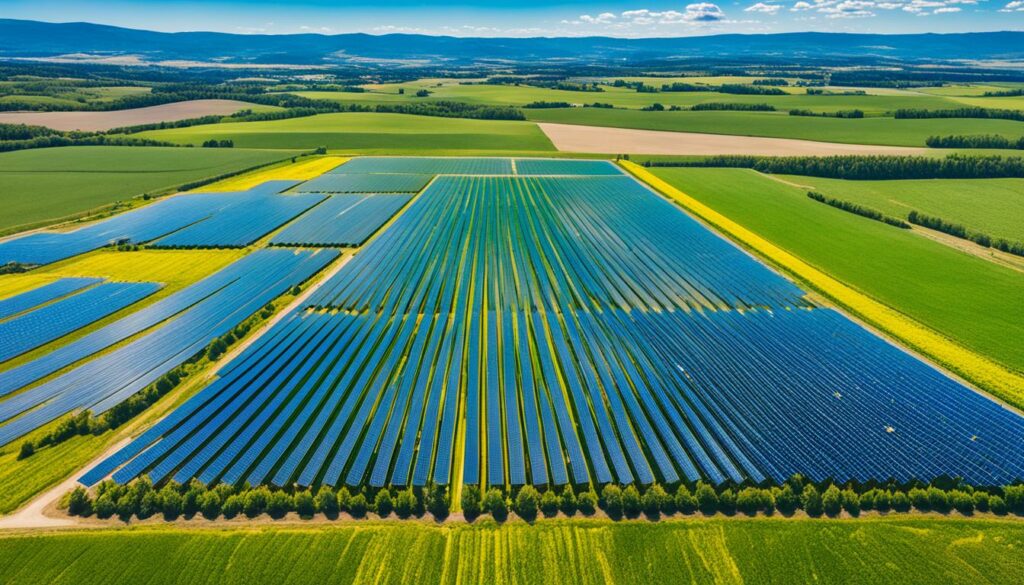
Technologies like editing a plant’s DNA directly can make these benefits even more precise. This way, plants can use nutrients more efficiently, needing less artificial help. This cuts down pollution and protects the environment.
But, there’s a challenge with getting these methods accepted in some places, like the EU and the Middle East. People there often worry about eating genetically modified food. Laws can also be tricky, making it hard to use these helpful technologies.
Despite these issues, using genetically modified crops is key for a sustainable future in food. In the US, these crops, like corn, cotton, and soybeans, are very common. They help reduce the need for harmful chemicals, making the world safer for all living things.
For example, cotton that insects don’t like has cut down on using pesticides a lot, protecting water from pollution. This is just one way biotechnology is making farming safer and better for everyone.
In the big picture, combining technology with farming offers hope for feeding the world while caring for the planet. We can keep improving and find new ways to work with nature. This is how we can feed a growing population and keep our environment healthy.
Transgenic plants mean crops are changed by adding genes from other species. These changes help make the plants better at fighting off pests and growing. This is important to help solve big challenges in farming around the world.
Transgenic plants, also known as GM plants, are made by adding genes from other living things. This allows scientists to create crops with special abilities. For example, a crop might be able to resist pests or survive weed killers. The goal is to make farming more reliable and eco-friendly.
There are many success stories thanks to transgenic plants:
Detailed research shows genetically modified crops bring big economic benefits in Europe. Studies also found they help farming cope with climate and population changes. This makes farming more sustainable over time.
Brookes and Barfoot (2014) found GM crops made a major economic impact from 1996 to 2012. They boosted food production and income globally. This shows their reach and importance.
Experts estimate the market for GM seeds will grow a lot by 2022. The increasing use of GM plants is a key part of farming’s future. They play a critical role in feeding the world.
Looking at real examples of biotech farming shows the big benefits. Genetically engineered crops help agriculture a lot. They can resist pests and survive herbicides. This means farming is more efficient and we get more crops.
Bt corn is a great example. It makes its own pest-fighting protein. This makes it strong against pests like the European corn borer. Almost 88% of corn in the US in 2012 was this type. This shows Bt corn benefits, like less pesticide and better profits.
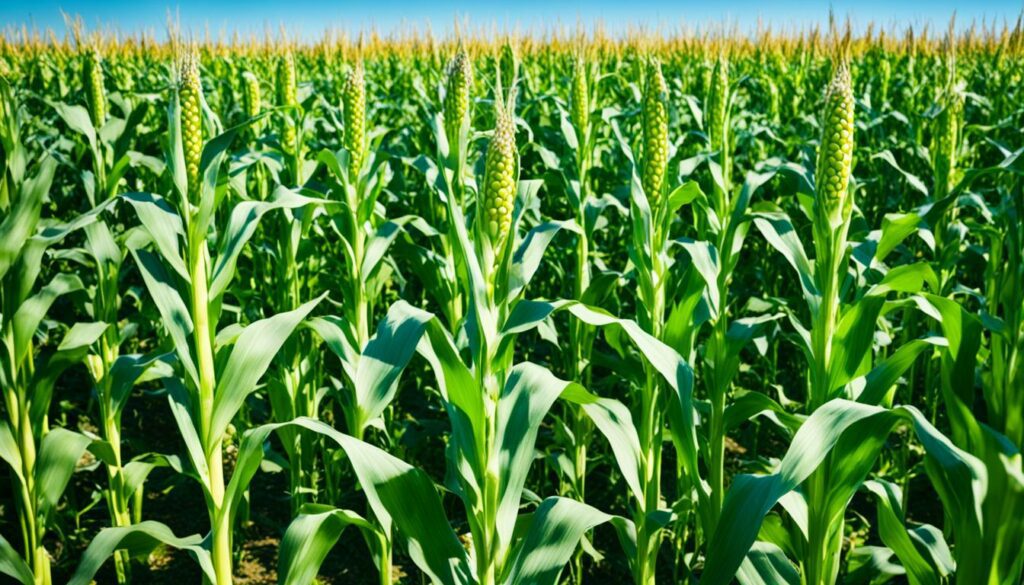
Herbicide-resistant soybeans are successful too. They can survive certain herbicides. This makes dealing with weeds easier and safer for the environment. In 2012, about 93% of US soybeans were these. It proves that herbicide-resistant crops are good for the planet and yield more.
| Crop Type | Biotech Planting Percentage (2012) | Main Benefits |
|---|---|---|
| Bt Corn | 88% | Reduced pesticide use, increased yield |
| Herbicide-Resistant Soybeans | 93% | Optimised weed control, environmentally friendly herbicides |
The biotech farming case studies show the big change biotechnology brings. With traits like pest resistance and herbicide tolerance, farmers do better. They harvest more but harm the environment less.
Gene editing, especially the CRISPR/Cas9 tech, has transformed agriculture. These breakthroughs help tackle farming issues, making crops stronger and more productive. The CRISPR system changes a plant’s DNA exactly, creating crops with better food value and the power to fight off tough conditions.
Gene editing’s big win is making it easier to select plants by needing less plant material. Marker-assisted selection lets breeders speed up their work, cutting costs and upping success rates. They use special markers to pick the best seeds early, saving time.
Using tools like genome sequencing and SNP tests, breeders gather tons of genetic details. This info speeds up making better crop types. Plus, it helps them understand crop traits at the genetic level, which is key for future improvements.
The future of farming with gene tech looks bright. As genomic tools get better and cheaper, we’ll learn more about crop genomes. Better genomic data and technology will make creating new crops faster and more targeted.
CRISPR is a game changer because it’s so exact and efficient. This tech has captured the world’s attention, winning a Nobel Prize in 2020. The US, Australia, and Canada are leading in patents for its use, with European and Chinese teams close behind.
Even with CRISPR’s rise, old methods like selective breeding are still very important. Combining different techniques is the best way to make real change in agriculture. This mix solves many farming challenges and opens new doors.
In the United States, three top federal agencies regulate GM crops. These are the U.S. Food and Drug Administration (FDA), the U.S. Environmental Protection Agency (EPA), and the U.S. Department of Agriculture (USDA). They work together following the Coordinated Framework for the Regulation of Biotechnology since 1986. Their goal is to make sure GM crops are safe for people, farmers, and the environment.

The three federal agencies have designated roles in managing GM crops:
The U.S. approval process for GM crops includes many steps to review and lower risks:
Starting in 2022, the National Bioengineered Food Disclosure Standard requires food companies to label genetically engineered foods. This is to show openness and help consumers make informed choices. It builds trust in GM foods.
The aim of the U.S. regulatory framework is to have GM crops meet high safety standards. They balance promoting new agriculture tech with keeping the public and the environment safe.
Genetic engineering needs careful safety checks and risk assessments. Before GMOs are used, they undergo thorough examination. This is to make sure they are safe for both the environment and our health. The aim is for GMOs to be more helpful than harmful.
First, we look at the big picture impact of GMOs on the environment. Experts like Brill say GMOs don’t do more harm than regular ones. Yet, studies like the one on genetically changed bacterium’s effect on the ocean show we need to keep researching. Other research on Trichoderma virens and Rhizobium leguminosarum suggest they don’t upset the natural balance much.
Health risks of GMOs are also carefully studied. The U.S. Department of Agriculture has strict safety rules for GMOs. They aim to keep us safe. They look closely at the health effects.
The American Medical Association’s Council is very involved. It checks GMOs’ effects on our food. For example, looking at Nicopica species helps spot possible allergies or toxins. Researchers also study the health effects of crops adapted to use certain carbon sources.
Overall, these detailed checks make sure GMOs are safe for us and the planet. This allows them to help meet food needs without harming nature.
Genetic engineering in farming changes how farmers work. It mainly includes using GE crops. These crops have traits like fighting pests and not being harmed by certain weed killers. They not only grow more but can save money by using less insecticides.
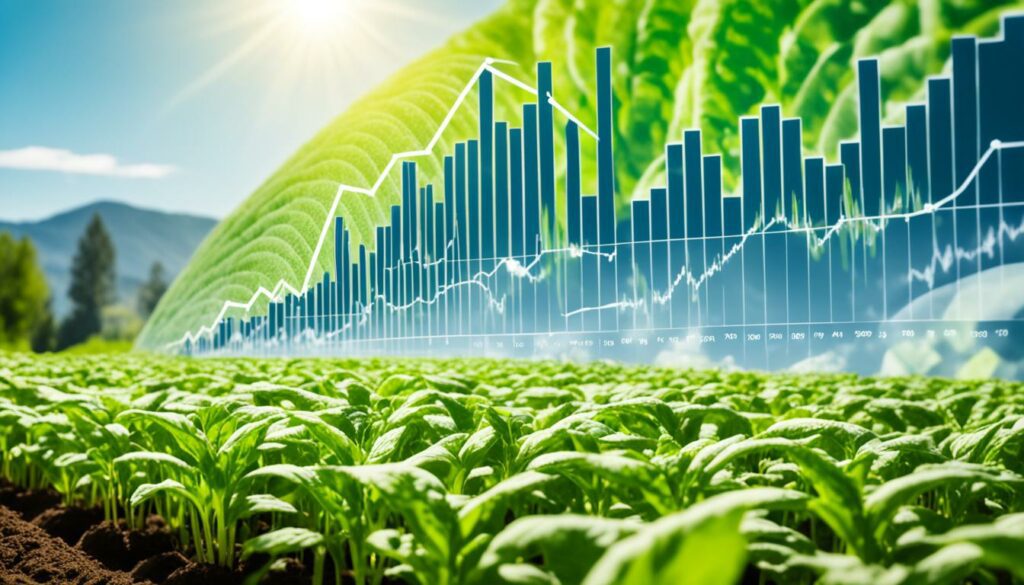
Farming with GE crops can bring in more money. Farmers find they make a 69% bigger profit mainly with soybeans, maize, and cotton. This happens because these crops can grow more without the need for lots of insecticides.
Even though GE crops might cost more to start with, they end up saving farmers money. This is because they can produce more with less spending, making them more profitable in the long run.
| Year | Study Focus | Notable Findings |
|---|---|---|
| 2002 | Introduction of β-carotene pathway in rice | Enhanced nutritional value |
| 2004 | Public attitudes towards biotechnology | Mixed perceptions |
| 2006 | Transgenic maize with virus protein | Improved disease resistance |
| 2007 | Value of GM crops in Europe | Economic benefits highlighted |
| 2008 | Genetic approaches for crop improvement | Adaptation to environmental changes |
Genetic engineering boosts farm and broader economic growth. GE crops help use resources better, raising incomes for farms and households. They also cut down on harm from pests and the use of insecticides.
With these benefits, farmers can earn more and improve their communities. The use of GE crops is making big positive changes in agriculture.
It’s an exciting time for farming, thanks to GE crops. By using these new methods, farms can expect to do even better in the future.
In the world of agricultural biotechnology, ethical issues around GMOs stir up deep and wide discussions. It’s all about the effects of changing genes on farming traditions and what we choose to eat. Many are worried about long-term impacts on the environment.
The views on genetic engineering are not all the same. Some praise it for improving crops and making food safer, but others urge caution. They’re worried this tech could harm our environment and natural places.
When it comes to the ethics of GMOs, things like owning life, big companies controlling seeds, and changing live beings raise big questions. We also worry about health issues like new allergies or stronger bacteria. These concerns are a call for honest talks to make sure we benefit from new tech without harm.
Talking about the ethics of GM crops openly and involving everyone helps. This way, we can handle the challenges of genetic engineering wisely and for the good of all.
The use of biotechnology crops differs a lot worldwide. This shows that different places have their own views and rules. For example, over 90% of certain crops in the United States use genetic engineering. This is a big number, showing how important this is in American farming. On the other hand, Europe and the Middle East use these crops less. They have stricter rules and people there are not very sure about them.
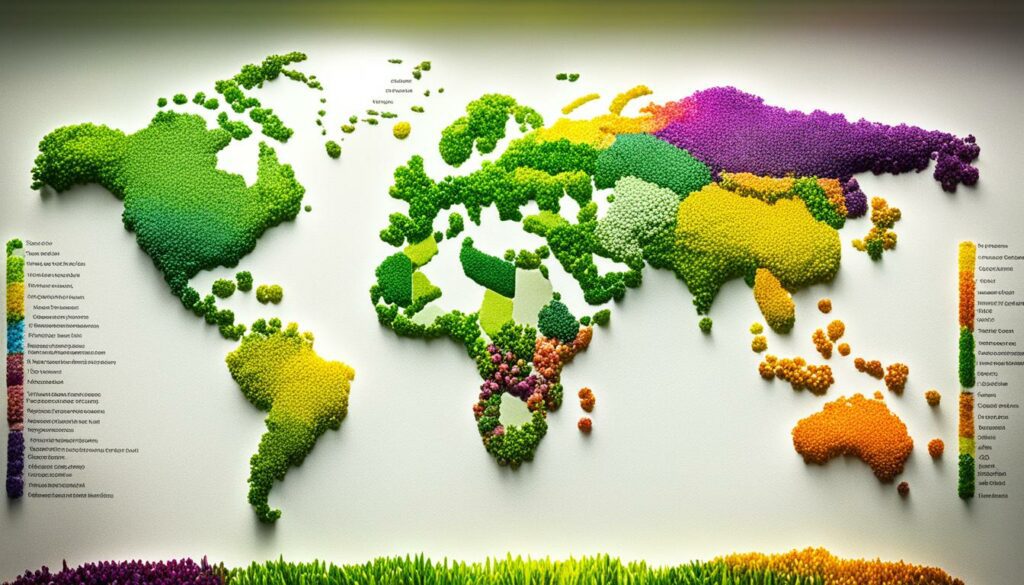
In the U.S., 95% of soybeans in 2023 were from seeds that can withstand certain weed killers. This number has been high since 2021, showing its ongoing success. The amount of cotton that can resist weed killers went from 10% in 1997 to 94% in 2023. And for corn, this number was 91% in 2023. All of this shows how much American farmers trust these new technologies. Bt corn, which fights off insects, saw its use grow from 8% in 1997 to 85% in 2023. These successes prove that using science in farming boosts how much food we can get from our fields.
Now, the trend in farming is moving towards crops improved with genes. This is different from before, when people mainly used modified crops. New ways to edit genes, like with CRISPR/Cas9, are making this change possible. This change could help get around the issues some people and rules have with traditional gene-modified crops. Places that have been cautious about gene science are starting to open up. They see it as a way to make sure we have enough food without harming the environment. This is thanks to the new tools we have that let us make crops fight off diseases better, deal with bad weather, and be more nutritious.
| Crop Type | Adoption Rate in 2023 |
|---|---|
| Herbicide-Tolerant Soybeans | 95% |
| HT Cotton | 94% |
| HT Corn | 91% |
| Bt Corn | 85% |
| Insect-Resistant Cotton | 89% |
| Stacked Seeds (HT & Bt Traits) | 82% of corn acres; 86% of cotton acres |
In the big picture, the world is seeing more and more farms use gene science in their crops. This is because it promises better harvests, safer food, and farming that doesn’t harm the earth. As we look at these signs, it’s likely we’ll see even more of these special crops in our fields. Many countries are starting to see how important using gene science in farming is for making sure there’s enough food and for making farming better.
Genetic engineering in farming offers big opportunities and poses challenges. It’s set to transform how we grow food. Yet, it faces several problems. These issues are key topics in conversations about modern farming technology.
One big hurdle is getting past the rules. Different places have different laws, which makes things hard. Countries in Europe and the Middle East, for example, limit or ban GM crops. This adds to the confusion for developers and farmers. Then, there’s the worry and the moral issues. People debate things like harm to wild species, if it’s good for the planet, and the effects on our health.
Genetic changes are complex and can be risky. Even with new tools like genome editing, there are still snags. These challenges mean we need careful tests and checks. Plus, patents and high costs can make it hard for all farmers to access this tech.
But, the opportunities in genetic engineering are huge. We can make crops that give more, are better, and can fight off bugs and tough weather. For example, some crops are now disease-proof and can survive tough climates. These changes could really help make sure everyone has enough food.
New tools like CRISPR/Cas9 offer big hopes. They may let us change crops in useful ways in a short time. This could make farming better against the changing climate. It’s good news for the environment too, as these crops may use less of our natural resources.
There’s also the chance to do more than just grow food or clothes. We can make plants that help us make medicine or clean up pollution. This could bring in money from new sources and make GM crops even more valuable.
In the end, to seize these chances, we must deal with the challenges. Working together worldwide, making clear rules, and listening to what the public thinks can lead us to a future where farming is both more productive and safer.
The future of genetic engineering in farming looks bright. It offers powerful tools to improve how we grow food sustainably. With almost all GM crops in Canada being canola, soybeans, and corn, their potential is clear.
In 2017, up to 100% of these crops in Canada were GM varieties. This shows just how important genetic engineering has become in modern agriculture.
Health Canada has given the green light to nearly 100 GM foods, like apples and soybeans. These foods have shown their value time and again. For example, GM salmon can reach market size twice as fast as non-GM salmon. Such advances show us what the future of farming might hold.
The use of GM crops that can withstand herbicides has also helped. It has boosted yields and cut down on herbicide use. This means less harm to the environment, like fewer greenhouse gases.
According to Klümper and Qaim, farmers who adopt GE crops see a 69% boost in profits. This is thanks to higher yields and less need for insecticides. The safety and effectiveness of GMOs are backed by scientific agreement.
Nations like India, China, Argentina, and Brazil are pushing ahead in biotechnology in farming. The way forward is to closely monitor, assess, and make policies. This is key to fully benefiting from genetic engineering and achieving sustainable food security.
Genetic engineering changes an organism’s genes using biotech. In farming, it alters crop genes to boost their abilities. This can make them more resistant to pests, diseases, and harsh conditions.
In farming, genetic engineering creates GMO crops with special traits. For example, some plants can survive weed killers or fight off pests. The method used, CRISPR/Cas9, is very precise.
GMO crops can grow more, need fewer pesticides, resist pests well, and be more nutritious. These changes help farms be more efficient and safer for the environment.
GMOs might harm the environment by affecting other living things. They could also lead to insects or plants becoming harder to control. Furthermore, safety concerns have been raised about eating GMO foods.
Insect-resistant crops, like Bt corn, have genes that make them toxic to some insects. But these genes don’t harm people or most animals. This reduces the need for harmful pesticides.
Drought-resistant crop types survive with little water, important in places hit by droughts. They help keep food production steady even when it’s very dry. This is key to not running out of food.
CRISPR/Cas9 is a tool for changing DNA with great accuracy. In farming, it’s used to grow crops that fight diseases better or are more nutritious. It’s quicker and more direct than old methods.
Gene editing changes DNA exactly as needed, much faster than normal breeding. Traditional breeding takes many generations to see results. Gene editing can do what traditional methods can’t more quickly.
Transgenic plants have genes added from different species to bring new helpful traits. These include resistance to pests or weed killers, or more nutrition. Normal breeding can’t add these unique traits.
Bt corn and herbicide-resistant soybeans are great examples. Bt corn stops pests without pesticide spraying. Herbicide-resistant soybeans make weeding easier. They show how biotech can reduce harm to the environment.
Tools like CRISPR/Cas9 are pushing gene editing forward. They help make crops more nutritious, better suited to the climate, or with traits farmers need. This technology is making big strides.
In the US, the USDA, FDA, and EPA check that GM crops are safe to eat and grow. They review them carefully. This ensures they’re good for people and the environment.
The safety of GMOs covers their impact on the natural world, non-GMO creatures, and people. Tests are done to check they won’t harm us or the planet. This happens before they’re used widely.
Genetic engineering makes crops yield more, costs less to grow, and cuts work costs. It helps farmers do better and adds to the economy. This new technology is very beneficial.
People debate about the good and bad of changing genes in crops. They talk about how it affects farms, what choices we have, and the future of the land. Many think we need to learn a lot more and be open about using this technology.
Many American farms use GMO crops, but some places in Europe and the Middle East are slower to agree. More people are preferring gene-edited crops because they seem more like what happens in nature naturally.
There are many hurdles, like laws, what people think, and questions about what’s right. But there are also big chances to make farming much better, safer, and ready for changes in the weather. Using new technology can help a lot.